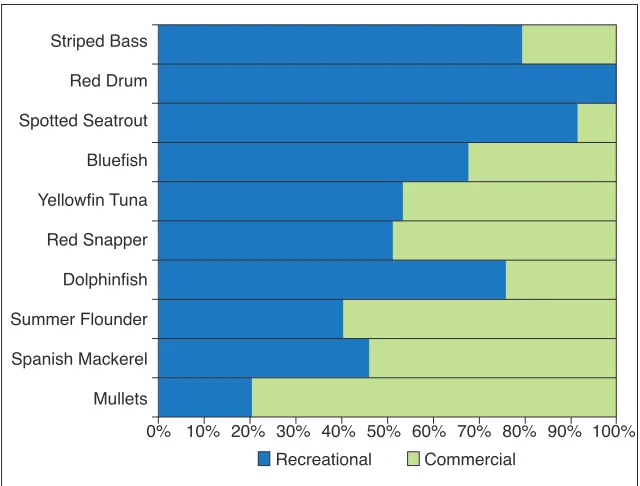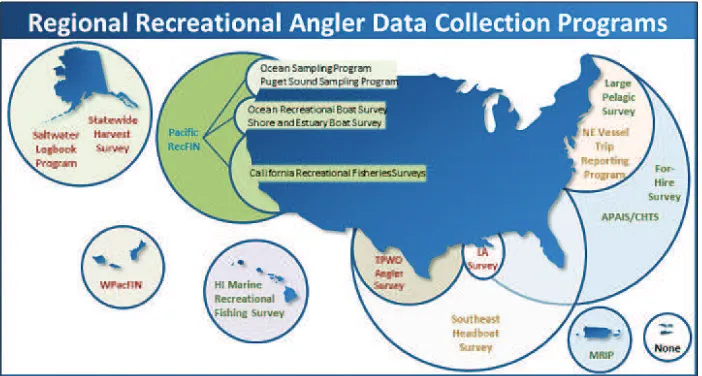Repor t
HigHligHts
Review of the Marine Recreational
Information Program (MRIP)
Work to redesign the National Marine Fisheries service’s recreational ishery survey program (now referred to as the Marine Recreational information Program) has yielded impressive progress over the past decade in providing more reliable catch data to ishery manag-ers. Major improvements to the statistical soundness of the survey designs were achieved by reducing sources of bias and increasing sampling eficiency as well as through increased coordination with partners and engagement of expert consultants. some additional challenges remain for the survey program, including those associated with nonresponse, electronic data collection, and communication and outreach to some audiences.
R
ecreational ishing is a favorite pastime in the United states. Although each angler may take only a small number of ish, collectively recreational ishing can have a signiicant impact on ish populations. For some species, recreational catch exceeds commercial catch—for example, in 2014, recreational ishing accounted for approximately 80 percent of the total catch of striped bass (see Figure 1).the National Marine Fisheries service of the National Oceanic and Atmospheric Administration is responsible for collecting data on ishing catch from saltwater anglers to ensure that ish populations are not over exploited. However, collection of data is dif-icult because there are many people ishing recreationally in many places, and there is no corollary to the landings data collected for commercial isheries. Hence, advanced survey methodology and complex statistical analyses are needed to assess the impact of recre-ational ishing on the nation’s ish stocks.
to collect the data, the National Marine Fisheries service implemented survey pro-grams starting in 1979 with the Marine Recreational Fisheries statistics survey (MRFss). Following a 2006 National Research Council review of that program, which called for modernizing the survey methods to reduce bias, increase eficiency, and build greater trust with the recreational angling community, the National Marine Fisheries service has undertaken a major overhaul of the recreational survey, now called the Marine Recreational information Program (MRiP).
After spending nearly a decade addressing the recommendations of the 2006 report, the National Marine Fisheries service requested an evaluation of the new survey pro-gram. this present report, the result of that evaluation, recognizes the major progress
January 2017
that the National Marine Fisheries service has made in redesigning the survey, highlights remaining challenges, and provides recommendations for address-ing them.
DESIGNING SURVEYS THAT
REACH SALTWATER ANGLERS
the Marine Recreational information Program primarily consists of an in-per-son survey of anglers at public ishing sites, called the Access Point Angler intercept survey (APAis); and an off-site survey, called the Fishing Effort survey (FEs). While the FEs collects data on ish-ing trips, (i.e., ishish-ing effort), the APAis collects data on the catch per trip, or catch per unit effort. the program also funds and supports a variety of region-, state-, species-, and sector-speciic sur-veys that either supplement or serve as alternatives to the APAis and FEs (see Figure 2). together, these data are used to generate estimates of total catch for recreational isheries.
the off-site portion of the former Marine Recreational Fisheries statistics survey, which collected information on ishing effort, was carried out by telephone, using random-digit-dialing to reach potential anglers in house-holds in coastal communities. the 2006 report cited a number of issues with this methodology, including potential bias and low data quality because increasingly fewer households have landline phones, the ineficiency of reaching households where there are no anglers, and a lack of coverage beyond coastal communities to reach anglers who travel to the coast for ishing trips.
the 2006 report suggested that a national reg-istry of all saltwater anglers could provide a more targeted sampling frame. Consistent with the report, the Magnuson-stevens reauthorization of 2006 called for a National saltwater Angler Registry, which was established in 2010. However, states allow various license exemp-tions—for example, exemptions based on age, mode of ishing, or access point. thus, the registry doesn’t pro-vide consistent coverage of the angler population.
to target angler households more eficiently and overcome the increasing ineffectiveness of phone-based surveys, the National Marine Fisheries service designed a mail survey and developed a sampling frame that used the National saltwater Angler Registry to supple-ment commercially available lists of mailing addresses. this led to impressive improvements in response rate
over the telephone survey, and the report’s authoring committee commends the National Marine Fisheries service’s innovative use of the registry.
the second component of the survey is the in-per-son survey of recreational anglers at shore or boat access points after they’ve been ishing. interviewers obtain information about the completed trip, including ishing locations, the species and number of ish caught, and the length of the trip. to overcome statistical shortcomings with the in-person survey of the Marine Recreational Fisheries statistics survey, MRiP updated its sampling method and, established a site registry. For example, interviews are now conducted at ixed time intervals at each site, with the busiest sites and times sampled with the greatest frequency.
FURTHER IMPROVEMENTS FOR THE
SURVEY
MRiP has upgraded the key statistical components of the survey, but there are a few areas that could beneit from further adjustments. For example, onsite surveys may fail to intercept anglers who have private access to the water. to compensate, ishing habits and success rates are assumed to be similar at public and private access sites. to help determine if this assumption is valid, the report recommends gathering information on site use by adding a question to the offsite mail survey asking
Figure 1. Recreational Catch Exceeds Commercial Catch for some Species. this chart shows recreational harvest and commercial harvest by weight for ten species commonly caught by marine anglers. For some spe-cies, such as striped bass, red drum, and spotted seatrout, recreational catch exceeds commercial catch. the chart does not include data from Alaska or texas as recreational weight data were not provided by those states. Credit: National Marine Fisheries service.
whether anglers ished from a pri-odology, such as asking people in advance to document their ish-ing trips for the next two months, could help reduce concerns about angler recall.
Changes in trends in survey responses could suggest prob-lems with nonresponse bias or the quality of the responses, or could indicate actual changes in ish-ing habits over time. Continuish-ing research on survey panels, where
a portion of the sampled households is retained for one or more interviews, would help assess trends and anom-alies in those trends, and would indicate improvements in data collection eficiency through increased participa-tion with a more engaged sample of anglers.
the quality of catch estimates depends on the response to the survey. the National Marine Fisheries service should consider conducting targeted annual nonresponse studies as a standard component of the MRiP to better address nonresponses in the survey results. Web questionnaires and mobile phone applica-tions for the off-site survey could help collect data that can be evaluated in real-time. the report recommends further evaluating options for electronic data collection for this purpose.
EVALUATING DATA COLLECTION
METHODS
the National Marine Fisheries service has made substan-tial progress in developing a framework for ongoing scientiic evaluation, review, and certiication of the methods, protocols, and procedures used for data col-lection. MRiP has beneited greatly from workshops and an independent research group of statisticians and survey methodologists who not only assess the general adequacy of MRiP but also provide technical advice to regional and state programs. Further, MRiP has developed a pilot studies program for develop-ing, testdevelop-ing, reviewdevelop-ing, and eventually certifying new sampling and estimation procedures. this process has been understandably slow to date, but should become
more timely as the program moves from testing to implementation.
Recently, MRiP has been evaluating and testing the use of electronic data collection technologies and their implications for statistical analysis. Four distinct initiatives are under consideration: for-hire electronic logbooks; angler electronic data reporting; sampler electronic data capture and submission; and electronic monitoring for validation. the use of electronic tab-lets for on-site surveys decreases the reporting time and, with added software, can increase data quality. However, self-motivated anglers reporting catches with apps present challenges for statistical estimation, because those people who self-report may not be repre-sentative of the target population.
in general, MRiP has done a good job evaluating new and emerging technologies for data collection. However, the perception in the angling community that MRiP is moving too slowly in incorporating these tech-nologies needs to be addressed. MRiP should develop a strategy to better articulate and communicate the complexities, costs, and timelines associated with using these technologies.
COORDINATION WITH REGIONAL
FISHERIES MANAGEMENT
the multi-jurisdictional nature of marine isheries man-agement, which in most regions of the country involves not just regional isheries management councils but multiple states and institutions, presents signii-cant coordination challenges to data collection, data
Copyright 2017 by the National Academy of Sciences. All rights reserved.
Division on Earth and life studies
management, stock assessment, and ultimately isheries management. to collect recreational isheries data that meet required standards for assessment and manage-ment, MRiP surveys are conducted in cooperation with a variety of regional and state agencies as well as other institutional partners.
Regional differences, and differences among various isheries within each region, can arise from a number of factors, including the amount and shape of the coast-line and other ocean features, species composition and diversity, and socioeconomic and demographic factors. Accommodating these regional differences requires the MRiP to adopt an implementation approach that incor-porates lexibility to address unique regional and state needs while at the same time maintaining the standard-ization and national-level cohesion recommended by the 2006 National Research Council report.
STRENGTHENING COMMUNICATIONS AND
OUTREACH
Overall, the MRiP has made signiicant advances in improving its communications and outreach strategy since the 2006 report, particularly with its new website and communication with some of its data-collection
COMMITTEE ON THE REVIEW OF THE MARINE RECREATIONAL INFORMATION PROGRAM
Luiz Barbieri (Co-Chair), Florida Fish and Wildlife Conservation Commission, st. Petersburg; Cynthia M. Jones
(Co-Chair), Old Dominion University, Norfolk, VA; Jill A. Dever, Rti international, Washington, DC; David Haziza, Université de Montréal, Montreal, Quebec, Canada; Jeffrey C. Johnson, University of Florida, gainesville; Bruce M. Leaman, international Paciic Halibut Commission, seattle, WA; Thomas J. Miller, University of Maryland Center for Environmental science, solomons; Sean P. Powers, University of south Alabama, Mobile; Steve Williams, Paciic states Marine Fisheries Commission, Portland, OR; Susan Roberts (Director, Ocean studies Board [OsB]), Stacee Karras (Program Oficer, OsB), David Policansky (scholar, Board on Environmental science and toxicology), Michael Cohen (senior Program Oficer, Committee on National statistics), Payton Kulina (senior Program Assistant, OsB),
Allie Phillips (Program Assistant, OsB), National Academy of sciences, Engineering, and Medicine
For More Information . . . this Report Highlights was prepared by the Ocean studies Board based on the report
Review of the Marine Recreational Information Program (MRIP). the study was sponsored by the National Oceanic and Atmospheric Administration. Any opinions, indings, conclusions, or recommendations expressed in this publication are those of the authoring committee and do not necessarily relect those of the sponsor. Copies of the report are avail-able from the National Academies Press, (800) 624-6242; http://www.nap.edu.
partners. However, communications with some other groups, most notably anglers but also some stock assess-ment and manageassess-ment groups, have been less effective.
the committee recognizes that MRiP defers to the state and regional partners in communications with anglers, an approach that may be the most successful in building trust and explaining the MRiP to anglers. However, the MRiP should play a leading role in devel-oping the vision and implementation strategies for communications with anglers, whether through its partners or through its own efforts.

